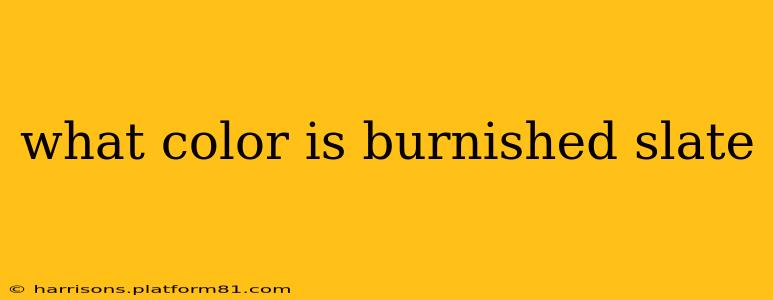Burnished slate is a captivating color that evokes a sense of sophistication and natural beauty. But pinning down its exact shade can be tricky, as it varies depending on the lighting and the specific formulation used by paint manufacturers or in describing natural slate. Generally speaking, it falls within a range of dark grays and muted browns, often with subtle hints of other colors. Let's delve deeper into the nuances of this popular color.
What is Burnished Slate?
The term "burnished" refers to a polishing or smoothing process, typically applied to metal or stone. In the context of color, burnished slate suggests a smooth, subtly reflective surface with a depth that goes beyond a simple flat gray. It's a color that captures light and shadow differently depending on the angle and surrounding environment. Think of the deep, rich tones of a well-worn, polished slate roof on a cloudy day.
What are the Dominant Hues of Burnished Slate?
The primary color in burnished slate is undeniably gray, but it's not a stark, cold gray. Instead, it's a warm gray, often with undertones of brown, purple, or even a touch of green. This complex interplay of hues is what gives burnished slate its unique depth and character. The specific shade can fluctuate dramatically depending on the manufacturer and the intended use – for example, a burnished slate paint will likely appear slightly different from a natural burnished slate stone.
Is Burnished Slate a Dark Color?
Yes, burnished slate is generally considered a dark color. Its proximity to black makes it a versatile option for various design applications. However, depending on the lighting conditions, it can appear lighter or darker, showcasing its subtle variations in hue.
What Other Colors Does Burnished Slate Resemble?
Because of its varied undertones, burnished slate often shares similarities with other colors, including:
- Charcoal Gray: A very dark gray with minimal other tones. Burnished slate is typically slightly warmer than charcoal.
- Gunmetal: A dark gray with metallic undertones. Burnished slate lacks this metallic sheen.
- Taupe: A neutral color that blends beige, brown, and gray. Burnished slate might lean towards a darker, cooler version of taupe.
- Deep Gray: A very dark gray that's still distinguishable from black. Burnished slate falls within this category, although its nuances set it apart.
How is Burnished Slate Used in Design?
The versatility of burnished slate makes it a popular choice in various design applications:
- Interior Walls: A striking backdrop for modern or rustic settings.
- Exterior Cladding: Adds a touch of sophistication and natural texture.
- Cabinetry: Creates a sleek, contemporary look in kitchens and bathrooms.
- Furniture: Provides a grounding element in various room designs.
- Accessories: Adds a touch of understated elegance to home decor.
How Does Lighting Affect Burnished Slate?
Lighting plays a crucial role in how burnished slate is perceived. In bright, direct sunlight, its subtle variations in hue become more apparent. In low light, it may appear much darker and more uniform. Therefore, always view samples under various lighting conditions before making a final decision.
By understanding the nuanced shades and variations of burnished slate, you can confidently incorporate this sophisticated color into your projects, adding a touch of natural elegance and depth to any space. Remember to view samples under various lighting conditions to ensure it complements your design vision perfectly.
